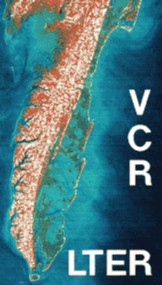 Spatial Variation in Ground-water Levels |

Laura E. Stasavich and Mark M. Brinson
Department of Biology
|
 Spatial Variation in Ground-water Levels |

Laura E. Stasavich and Mark M. Brinson
Department of Biology
|
The central hypothesis of the VCR LTER is that ecosystem, landscape, and successional patterns are controlled by the relative vertical positions of the land, sea, and fresh-water table, also known as "free surfaces". Here we present for comment and discussion progress toward monitoring and analyzing data on free water surfaces at Brownsville and Hog Island since 1991. Examples of representative data are shown ranging from creekbank environments to high marshand terrestrial sites. Free water surfaces, relative to that of land, show dynamics that are characteristic at each site. Creekbank sites respond predictably to tides while interior sites are largely atmospherically controlled. Recently, HOBO recorders using pressure transducers have been compared with Stevens recorders using floats and stilling wells. Owing to differing sizes in stilling wells of the HOBOs and Stevens recorders, some differences in water table response appear. Some sources of error between the Stevens recorders and HOBOs can be identified and isolated. These data are being added to the long term database for the LTER site. Comments are solicited on the application of these data to individual projects, and the desirability of continuing or discontinuing individual stations.